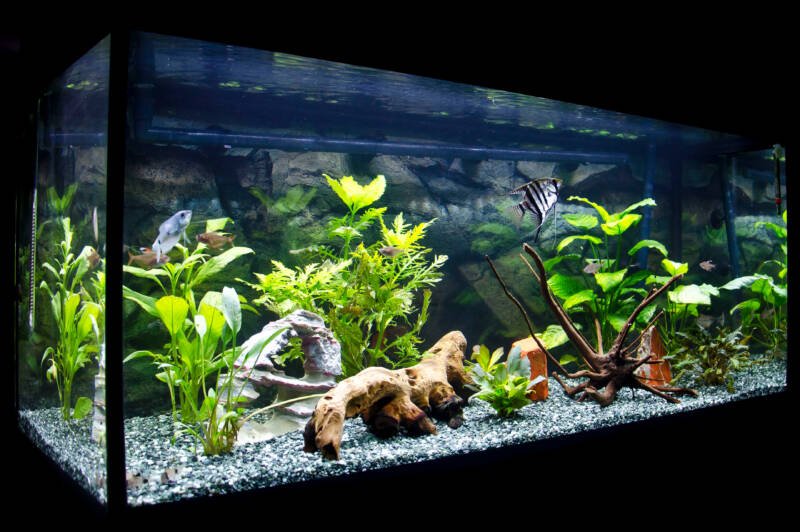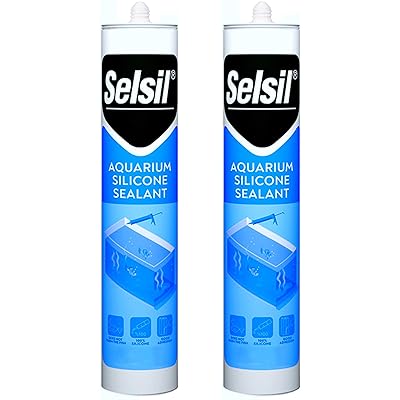Glass aquariums are constructed of glass panels held together by a silicone-based sealant.
The sealant holds the glass panels together and provides a waterproof seal.
Sometimes, if the factory seal is not applied properly, a new aquarium will have a leak as soon as you fill it up. Old aquariums that have been moved a lot can also develop a leak along the seal.

If this happens to you, don’t panic. You can repair a leak at home using a silicone sealer.
If you’re going to make a repair, it’s important to understand how aquariums are manufactured. Then, you must use the proper silicone for a safe and effective repair.
In this article
How aquariums are made
There are several styles of aquariums: rimless, beveled edge, all-in-one with a built-in filter, and the traditional tanks with a frame on the top and bottom.
No matter what style, they are all constructed using a silicone sealer.
The aquarium manufacturer uses a special silicone product that has high tensile strength. This is necessary to counteract the force of the aquarium water pushing on the glass panels.
The glass panels are assembled with a thin layer of silicone in-between the glass panels. This gives the tank its strength. Once this is dry, the second bead of sealant is applied around the base and walls inside the aquarium for a water-tight seal.
Large tanks will use a plastic or aluminum frame at the top and bottom to counteract bowing of the glass.
Symptoms of a leaking aquarium
Sometimes a leak appears as a tiny stream of water squirting from a corner of the aquarium.
The water pressure inside the aquarium is forced through a pinhole-sized break in the silicone seal.
You may not see a stream of water. Often, you’ll notice the water level in the aquarium is dropping faster than normal.
The other symptom is water collecting along the bottom frame of the aquarium. Water can be slowly leaking from a side or bottom seal.
With slow leaks, you may discover water behind the tank or soaking into the carpet.
Check all the side seals along the edges of the aquarium. If there’s a leak, you’ll feel wetness at the point where the seal has failed.
If you can’t find the leak on the edges of the aquarium, it may be at the base of the tank.
How to fix the leak
If the leak is on a corner of the aquarium, you may not have to completely drain the tank.
Lower the water level below the leak. Using a razor or hobby knife, carefully remove a few inches of silicone from inside the aquarium.
Cut away only an inch or so above and below the leak. The new silicone won’t stick to the old seal, so make sure all old sealant is removed.
For the new silicone to stick, the glass must be clean and completely dry. It helps to wipe the area with rubbing alcohol to remove residue from the glass.
Apply a bead of silicone to replace what you removed. Don’t touch the silicone for at least 24 hours.
Once the silicone is completely dry, refill the aquarium.
What to do if you can’t find the leak
The toughest leak is one you can’t locate. Often it is on the bottom glass panel.
You’ll have to completely empty the tank, removing all the gravel too. Remove the frame from the bottom of the tank so you can look for the leak.
It helps to add water to the tank and look for the spot where water is leaking.
Once you find the leak, cut away the silicone on the bottom of the tank. Clean the area and apply a bead of silicone.
Allow the sealant to completely dry then fill the tank with water. Check for leaks over the next 24 hours.
Choosing the right silicone
It may seem convenient to stop by your local home center to pick up a tube of silicone sealant.
You can find many types of calk, glue, and silicone-based products. But chances are none of these will work in an aquarium.
These products are all specialized to perform specific adhesive and sealing properties around the home, not in your aquarium.
Home repair silicone-based products contain a variety of additives that make them effective at sealing rough, porous surfaces or around sinks and showers.
Some contain additives that help them last longer under freezing temperatures. Other sealants contain biocides to inhibit mold growth.
Even though the label says silicone, it does not mean it will work submerged underwater or that it is safe for aquatic life.
Silicone sealants for aquarium use
Silicone sealants formulated to work when submerged in water and be safe for aquatic life will say so on the product label.
If the label does not say it is for aquariums, DO NOT use it! Even if the product is safe for fish, it may not be designed to adhere to non-porous surfaces like aquarium glass.
Here are a number of aquarium-safe silicone sealants to choose from.
Selsil is 100% silicone with no added mold inhibitors. It is clearly labeled for aquarium use.
This brand is only available in a calk tube dispenser. You will need a calk gun to apply it.
Selsil adheres to non-porous surfaces like aquarium glass. It dries clear and remains flexible underwater.
It can also be used to repair damaged ceramic aquarium ornaments. If you’re using ozone in your skimmer, it won’t damage this sealant.
It’s also UV resistant and will remain flexible even if exposed to sunlight. Cure time is 24 hours.
ASI Aquarium Silicone Sealant has been specifically formulated to assembly fresh and saltwater aquariums.
This is a professional-grade RTV Silicone Sealant that forms a strong bond to the glass.
The seal is not affected by exposure to salt or freshwater. ASI silicone is non-toxic to fish.
ASI Aquarium Silicone Sealant is non-runny and can be applied to vertical surfaces without sagging.
ASI is only available in a calk tube dispenser. It requires a calk gun to apply it. ASI clear sealant can also be used to repair reef sumps.
Aqueon is a well-known manufacturer of aquarium products. Aqueon silicone sealant is packaged in convenient squeeze-tubes, like toothpaste.
This makes it easy to apply in tight places. You don’t need a calk gun to apply this sealant.
Aqueon claims their product is the same as professional-grade silicone sealants used to manufacture aquariums. It dries clear and remains flexible in freshwater and saltwater aquariums.
It is available in black in case your tank has black silicone sealant.
This silicone sealant is black in color. It’s great for tanks manufactured with black silicone.
Many aquarists prefer black sealant when assembling a rock wall or cave. Pond owners also use black silicone to stabilize rock waterfalls.
Aquascape black silicone comes in a calk tube, making it ideal for constructing a waterfall and other large sealing jobs. It is also available in a smaller squeeze tube.
It is 100% non-toxic to aquatic life. Will remain flexible even when exposed to sunlight.
Loctite is a world-famous manufacturer of specialty adhesives for professionals and DIY projects.
Loctite clear silicone looks like something you would find at a hardware store, but the company says the sealant is completely safe for aquarium use.
The small tube is easy to use and is resealable. Like other silicone products, Loctite provides good adherence to glass and rocks.
It won’t break down in sunlight and is ozone resistant. You can use this sealant in freshwater, saltwater, and terrariums.
You can even use it to attach plastic plants to rocks for a custom aquascape.
Mitreapel is a Canadian supplier of adhesive products. Their aquarium sealant contains no extra chemicals like mold inhibitors.
It can be used to seal PVC, glass, stone, and fiberglass materials. It requires 24 hours to cure.
The product is supplied in a calk tube and requires a calk gun to use. Use this sealant to repair leaks in aquariums and sumps.
It can be used to stabilize rocks inside the tank and around the pond. It dries clear and is resistant to UV (sunlight) and ozone.
APEL silicone is compatible in saltwater and freshwater applications.
Recommendations
If you’re repairing a small leak or putting together a rock wall in your aquarium, there’s no need to buy a large tube of silicone and gun.
A small squeeze tube of aquarium silicone will be easier to work worth. Aqueon and Loctite offer aquarium sealant in convenient sizes for small projects.
If you’ve got a big project or are working on a waterfall on your pond, a big tube of silicone makes sense.
ASI clear silicone is a truly professional product that stays put until it cures. If you need work with black silicone, Aquascape Black Silicone is the way to go.
If you have comments or questions, please post them below.





